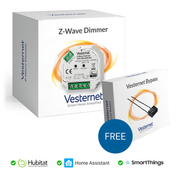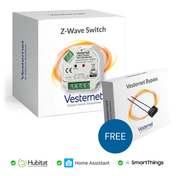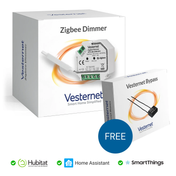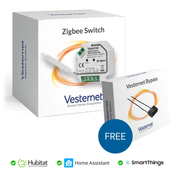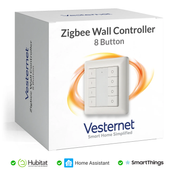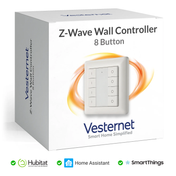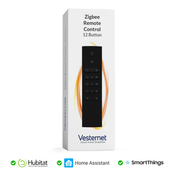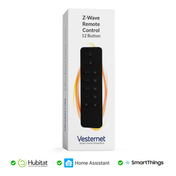A Scene enables you to control various devices on your home automation network with one single command. You define what will happen when a specific Trigger event occurs. The trigger condition can be another Device event or a Schedule task.
For example you can create a scene to automatically turn the lights on whenever a door is unlocked during a certain period or close your shades fifteen minutes after sunset.
Create a Scene
Creating a new scene is easy:
- Click Scenes on your VERA Dashboard to get started. A list of the existing scenes – if any – is displayed.
- Select the Add Scene button to begin creating a new Scene.
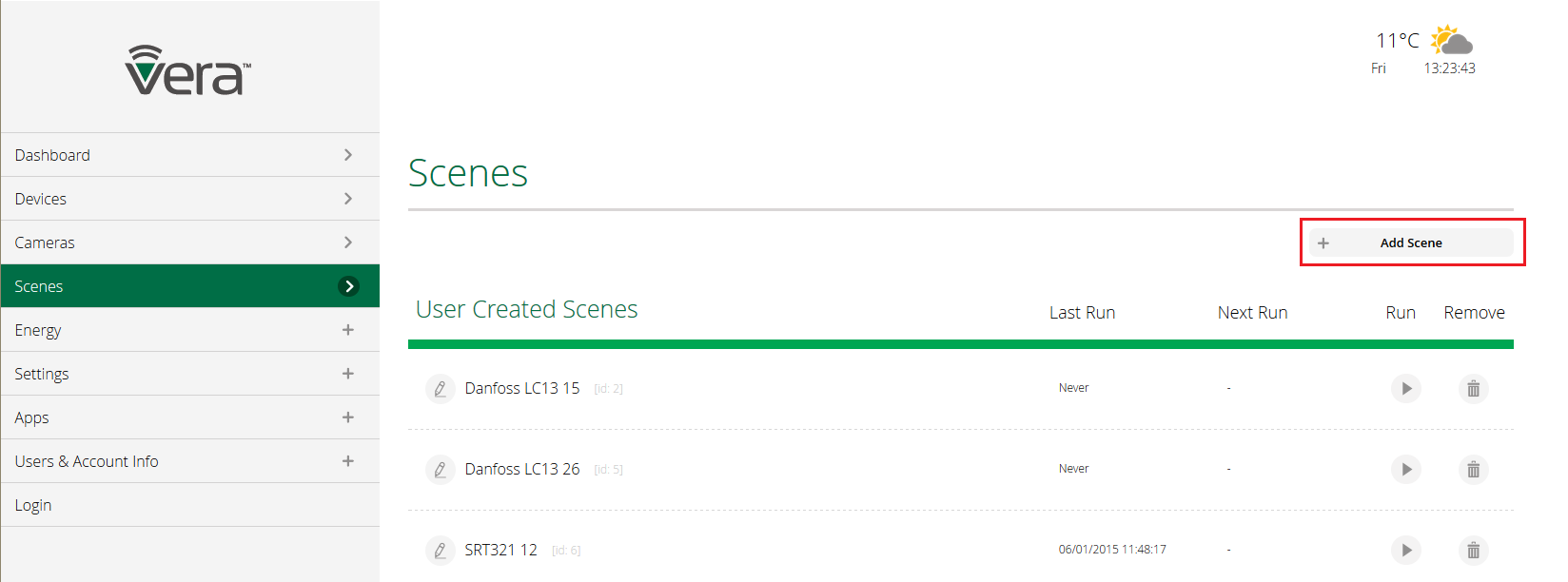
- A Help Panel is available providing some extra information explaining the process.

Creating a Scene consists of two basic steps: selecting one or more Triggers that activates the Scene and selecting one or more resulting Actions.
Additional configuration can be made to add Modes validation , Notify user and LUUP Code.
Triggers
There are three types of Triggers:
- Device Event - The Scene will begin when a sensor or other Device in your system changes state, such as a door opens or temperature changes.
- Schedule - The Scene will begin hourly, daily, weekly, monthly or according to whatever schedule you choose, or can be based on sunrise/sunset times for your specific location.
- Manual - You'll create a new button that appears on your Dashboard, and selecting this button will start the Scene.
For this example we will create a scene that will turn on two lights when motion is detected.
- Select Device as the trigger method.
- Click the right arrow button to see a list of available devices.

The list may be organized by Room or Type and only devices that can be used as a trigger will be listed.
- For this example, we're going to use the Motion Sensor section of the Fibaro Sensor, so we'll select the right arrow next to this device.
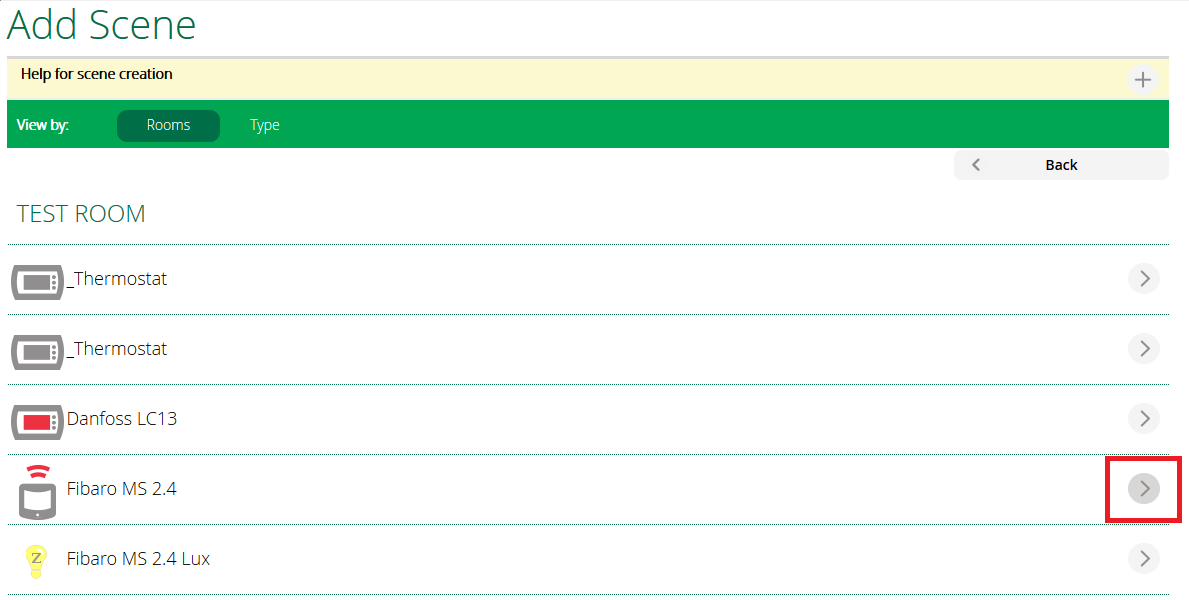
The Motion Sensor has several possible parameters that can be used to trigger the Scene, including whether it is armed or disarmed when motion is detected, and when the battery level is low.
- For our Scene we want the lights to turn on regarding if the sensor is armed or disarmed so we’ll choose the third option.
- Click Validate to move into the next screen. Here you can check if the Trigger was properly setup and add another trigger if you need to.
- For this example we’ll just use the Motion Sensor so select Next Step at the bottom.


Time Restrictions
It is possible to restrict a trigger to certain times.
In this example I’m going to restrict the Motion Detected event to Trigger our scene every day only from 20h to 07h.
- Click on the small Clock icon on the top right corner.

- Activate the Restrict the trigger to certain times options and select the Days and Time Interval you want the Trigger to be active.

- Click Done to move into the next step.
Actions
In this step we’ll tell VERA what will happen immediately when the Motion Sensor – our trigger – detects motion.
- Go ahead and click Select Devices.

Similar to the previous step we’ll see a list of available devices. In this case only devices that can perform some actions will be shown.
From this list we’ll select the devices we want to control.
- For this example we want two lamps controlled by a TKB Power Socket and a Swiid to turn On.

- A small menu will appear asking what those devices should do. We set this to On.
- Click Validate to move into the next screen.

As an option we can add a Delayed Action to this Scene.
For example we may want to have the lights On for only 15 minutes so we would add a Delayed Action turning those devices Off after a 15 minutes delay.
- We’ll skip that for now so move ahead to the next step.

Finish the Scene
In this step we finish up the scene with a few more details such as Modes when we want the scene to run, Notifications, LUUP Code and of course Scene Name.

Modes
You can filter in which Modes you want this Scene to be active. By default the Scene will run all the time, regardless of whether we're Home, Away or on Vacation - that's what When I am in any mode means.
We want our Test Scene to run only when we are Away so we need to change this default setting.
- Click on the right arrow next to When I am in any mode
- We next see a choice of which Modes to activate the Scene for, and select only Away here, and click Done.

Notifications
We can tell VERA who we want to notify whenever the Scene runs. We could choose to send an email or text notification to any user registered on our unit.
Realistically, such notifications are more useful for security applications so you probably won’t be using this on a daily basis.

LUUP Code
In this step you can add custom LUUP code to your Scene. You can use this to make a scene conditional – "do something only if some condition is met" – or to do very advanced operations.
This is strictly for Advanced Users only and we won’t be covering that on this guide. For an overview of the LUUP potential see the Luup Scenes Events page.

Naming your Scene
You can name a Scene anything you want, but the more descriptive you make it the less confusing things will be later on when you have many Scenes.
Make sure to assign it into a Room so we can keep everything on its place.

The new Scene now appears under Scenes on our Dashboard. It's also easy to edit the Scene by clicking on the pencil icon to the left of the Scene name in case you need to make some changes.

Testing the Scene
The new Scene will automatically be active in the Modes that were selected when it was created, in this case Away mode only. At this point we can leave the Scenes tab and return to the main Dashboard tab.
Before leaving however, we might want to test our new Scene using the Run button. This does not test the entire Scene, but rather, it tests the Action that is set to occur in the Scene.
So in the Scene we've created, instead of waiting for motion to occur, we can test our Scene by clicking the Run button and observing whether the light comes on.
It should take just a few seconds to run the Scene, during which time the Run button changes to a check mark and Success appears if it runs OK. If there's a problem, the error or fail symbol will appear, as shown in the legend underneath.

This was just a quick walk-through of Scene creation and there are an infinite number of possibilities.
Scenes empower you to automate your home beyond imagination so feel free to experiment – if you don’t like the outcome you can always remove it and start over!
Video
Take a look at the videos to see how easy it is to create Scenes in VERA.
Related Information
- APNT-101: Adding Devices in VERA UI7
- APNT-102: Adding Device Parameters in VERA UI7
- APNT-104: Scheduling Scenes in VERA UI7
- VERA Support: Adding Devices
- VERA Support: Creating your own Scenes

